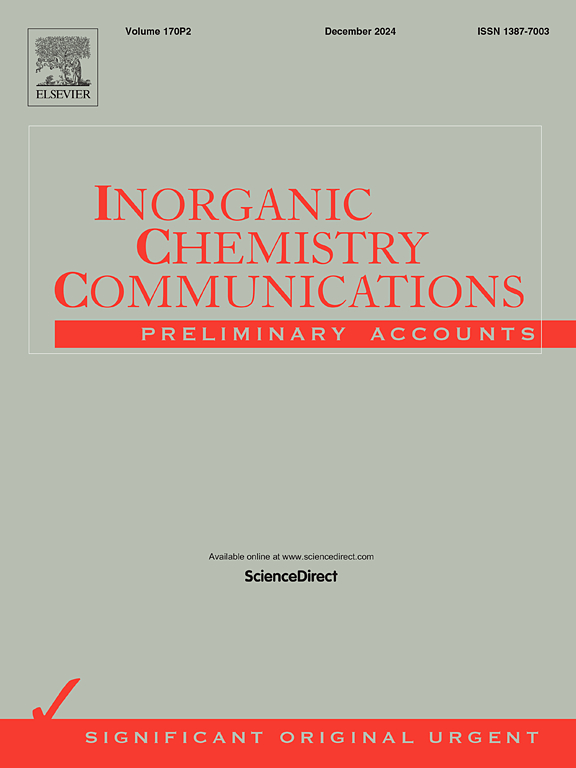Comparative theoretical analysis on the adsorption of cationic and anionic dyes on metal iodides in water
IF 4.4
3区 化学
Q1 CHEMISTRY, INORGANIC & NUCLEAR
引用次数: 0
Abstract
This study focused on the comparative analysis of the adsorption of cationic safranine O (SF+) and anionic acid blue 25 (AB−) on (1 1 0) surface of magnesium, manganese, zinc, and nickel metal iodides using DFT and molecular dynamics (MD) simulation. The nature of the interactions has been thoroughly investigated by the HOMO/LUMO energy gap, global reactivity descriptors, Mulliken charge distribution, molecular electrostatic potential (MEP) map, adsorption energy, and natural bond orbital (NBO) analysis. The reactivity of the two dyes was compared based on the LUMO and HOMO energy levels. It was found that SF+ with a LUMO value of −0.991 eV and lower energy gap of 1.184 eV exhibits an electrophilic characteristic and high ability to be strongly adsorbed on the MI2. However, AB− exhibits a higher energy gap of 5.854 eV, indicating its lower reactivity compared to SF+. Mulliken charge distribution of the dyes and their MEP map also showed strongly negative and strongly positive sites. Subsequently, the stabilizing interactions of hyper-conjugation and charge delocalization have been evaluated. In addition, the MD simulation was employed to elucidate the mechanism of the dye’s adsorption on the adsorbent surfaces. The results suggest that the dyes are adsorbed on the four metal iodides in a close parallel position with less adsorption energy for SF+ compared to AB−. Finally, it was found that the Van der Waals forces are predominant in the adsorption process suggesting a physisorption mechanism in accordance with RDF analysis.

阳离子和阴离子染料在水中金属碘化物上吸附的比较理论分析
采用DFT和分子动力学(MD)模拟方法,对阳离子藏红花O (SF+)和阴离子蓝25 (AB−)在镁、锰、锌和镍金属碘化物(11 10)表面的吸附进行了比较分析。通过HOMO/LUMO能隙、整体反应性描述符、Mulliken电荷分布、分子静电势(MEP)图、吸附能和自然键轨道(NBO)分析,深入研究了相互作用的性质。根据LUMO和HOMO能级比较了两种染料的反应活性。结果表明,LUMO值为- 0.991 eV,能隙为1.184 eV的SF+具有亲电特性,在MI2上具有很强的吸附能力。然而,AB−的能隙较高,为5.854 eV,表明其反应活性低于SF+。染料的Mulliken电荷分布及其MEP图也显示出强负电荷和强正电荷。随后,对超共轭和电荷离域的稳定相互作用进行了评价。此外,采用MD模拟的方法阐明了染料在吸附剂表面的吸附机理。结果表明,染料在四种金属碘化物上的吸附位置接近平行,对SF+的吸附能比AB−小。最后,发现在吸附过程中,范德华力占主导地位,表明其物理吸附机制符合RDF分析。
本文章由计算机程序翻译,如有差异,请以英文原文为准。
求助全文
约1分钟内获得全文
求助全文
来源期刊

Inorganic Chemistry Communications
化学-无机化学与核化学
CiteScore
5.50
自引率
7.90%
发文量
1013
审稿时长
53 days
期刊介绍:
Launched in January 1998, Inorganic Chemistry Communications is an international journal dedicated to the rapid publication of short communications in the major areas of inorganic, organometallic and supramolecular chemistry. Topics include synthetic and reaction chemistry, kinetics and mechanisms of reactions, bioinorganic chemistry, photochemistry and the use of metal and organometallic compounds in stoichiometric and catalytic synthesis or organic compounds.
 求助内容:
求助内容: 应助结果提醒方式:
应助结果提醒方式:


